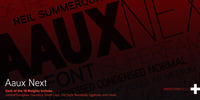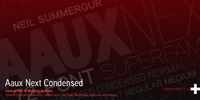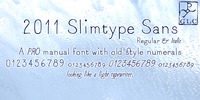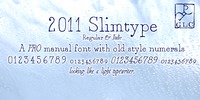Download Abbey Road NF Font Family
Here’s a fresh take on an old favorite, originally named Abbott Old Style, which exudes antique charm, and also suggests exotic locales.
Here’s a fresh take on an old favorite, originally named Abbott Old Style, which exudes antique charm, and also suggests exotic locales.
Here’s a fresh take on an old favorite, originally named Abbott Old Style, which exudes antique charm, and also suggests exotic locales.
font family from Suomi, added yesterday
A Sans font family of five weight for headline and text use, with old style numerals and small caps, and extensive kerning.
font family from Suomi, added yesterday
A Sans font family of five weight for headline and text use, with old style numerals and small caps, and extensive kerning.
The Aban font family was designed by Naghi Naghashian. It is developed on the basis of specific research and analysis on Arabic characters and definition of their structure. This innovation is a contribution to modernization of Arabic typography, gives the font design of Arabic letters real typographic arrangement and provides more typographic flexibility. This step was necessary after more than two hundred years of relative stagnation in Arabic font design.
Aban supports Arabic, Persian, and Urdu. It also includes proportional and tabular numerals for the supported languages. Aban Font Family is available in three weights: Regular, Bold and ExtraBold, a three stings outline font. More…
The Aban design fulfills the following needs:
A Explicitly crafted for use in electronic media fulfills the demands of electronic communication. Aban is not based on any pre-digital typefaces. It is not a revival. Rather, its forms were created with todays technology in mind.
B Suitability for multiple applications. Gives the widest potential acceptability.
C Extreme legibility not only in small sizes, but also when the type is filtered or skewed, e.g., in Photoshop or Illustrator. Abans simplified forms may be artificial obliqued in InDesign or Illustrator, without any loss in quality for the effected text.
D An attractive typographic image. Aban was developed for multiple languages and writing conventions.
E The highest degree of geometric clarity and the necessary amount of calligraphic references. This typeface offers a fine balance between calligraphic tradition and the contemporary sans serif aesthetic now common in Latin typography.
The Aban font family was designed by Naghi Naghashian. It is developed on the basis of specific research and analysis on Arabic characters and definition of their structure. This innovation is a contribution to modernization of Arabic typography, gives the font design of Arabic letters real typographic arrangement and provides more typographic flexibility. This step was necessary after more than two hundred years of relative stagnation in Arabic font design.
Aban supports Arabic, Persian, and Urdu. It also includes proportional and tabular numerals for the supported languages. Aban Font Family is available in three weights: Regular, Bold and ExtraBold, a three stings outline font. More…
The Aban design fulfills the following needs:
A Explicitly crafted for use in electronic media fulfills the demands of electronic communication. Aban is not based on any pre-digital typefaces. It is not a revival. Rather, its forms were created with todays technology in mind.
B Suitability for multiple applications. Gives the widest potential acceptability.
C Extreme legibility not only in small sizes, but also when the type is filtered or skewed, e.g., in Photoshop or Illustrator. Abans simplified forms may be artificial obliqued in InDesign or Illustrator, without any loss in quality for the effected text.
D An attractive typographic image. Aban was developed for multiple languages and writing conventions.
E The highest degree of geometric clarity and the necessary amount of calligraphic references. This typeface offers a fine balance between calligraphic tradition and the contemporary sans serif aesthetic now common in Latin typography.
family of 8 fonts from T-26

When the original Aaux was introduced in 2002, I intended to go back and expand the family to offer more versatility. Years went by before I was willing to pick it up again and invest the proper time into building a viable and useful recut.
Just putting a new designation and tweaking a few glyphs here and there would not do the designer or the typeface justice; instead, I chose to redraw each glyph’s skeleton from scratch for the four main subsets of the super family along with their italics.
Each glyph across the super family is ‘connected at the hip’ with each styleeach character carries the no frills, simple architecture that endeared so many users to it. More…
The new recut expands the family to an enormous 72 typefaces! The original has spawned Compressed, Condensed and Wide subsetsall with corresponding weightsfor complete flexibility.
Additionally, all of the original weight variants have all been incorporated within the OpenType shell: Small Caps and Old Style Figures are there along with new tabular figures, numerators and denominators, expanded f-ligatures and a complete Central European character set.

When the original Aaux was introduced in 2002, I intended to go back and expand the family to offer more versatility. Years went by before I was willing to pick it up again and invest the proper time into building a viable and useful recut.
Just putting a new designation and tweaking a few glyphs here and there would not do the designer or the typeface justice; instead, I chose to redraw each glyph’s skeleton from scratch for the four main subsets of the super family along with their italics.
Each glyph across the super family is ‘connected at the hip’ with each styleeach character carries the no frills, simple architecture that endeared so many users to it. More…
The new recut expands the family to an enormous 72 typefaces! The original has spawned Compressed, Condensed and Wide subsetsall with corresponding weightsfor complete flexibility.
Additionally, all of the original weight variants have all been incorporated within the OpenType shell: Small Caps and Old Style Figures are there along with new tabular figures, numerators and denominators, expanded f-ligatures and a complete Central European character set.

When the original Aaux was introduced in 2002, I intended to go back and expand the family to offer more versatility. Years went by before I was willing to pick it up again and invest the proper time into building a viable and useful recut.
Just putting a new designation and tweaking a few glyphs here and there would not do the designer or the typeface justice; instead, I chose to redraw each glyph’s skeleton from scratch for the four main subsets of the super family along with their italics.
Each glyph across the super family is ‘connected at the hip’ with each styleeach character carries the no frills, simple architecture that endeared so many users to it. More…
The new recut expands the family to an enormous 72 typefaces! The original has spawned Compressed, Condensed and Wide subsetsall with corresponding weightsfor complete flexibility.
Additionally, all of the original weight variants have all been incorporated within the OpenType shell: Small Caps and Old Style Figures are there along with new tabular figures, numerators and denominators, expanded f-ligatures and a complete Central European character set.

This is the definitive standard African font. It combines wonderful readability with tremendous panache. The fact that it has a full character set (UPPER and lower case), all punctuation and all special characters, means that it can be used in just about any African design context.
If you had only one African font in your arsenal, it would have to be Aarde Black.
The name “Aarde” means “earth” and refers to the gutsy, earthy character of the letterforms.
It includes a full character set: characters for English, French, Italian, German, and Portuguese.
More…
The numerals are mono-spaced, and are very readable so that they will line up correctly in columns of figures. The letters of the alphabet are correctly kerned so that they appear correctly in text.
family of 6 fonts from A2-TYPE
Beckett, 6 Weights. Designed for the Faber & Faber series of book covers: Samuel Beckett Complete Works', published in 2009/10. This face originates from machine-cut era wood type characterized by a hard edge that creates immediate impact on any surface, print or screen!
family of 6 fonts from A2-TYPE
Beckett, 6 Weights. Designed for the Faber & Faber series of book covers: Samuel Beckett Complete Works', published in 2009/10. This face originates from machine-cut era wood type characterized by a hard edge that creates immediate impact on any surface, print or screen!

Here’s a Morris line; a traditional and legible font in small sizes, but almost abstract in big sizes.
Named after my son Morris and it’s got nothing to do with a certain musical...

Here’s a Morris line; a traditional and legible font in small sizes, but almost abstract in big sizes.
Named after my son Morris and it’s got nothing to do with a certain musical...

This light manual font, with two styles, is the sans serif version of our slab serif “2011 Slimtype”. It is containing Western and Northern European, Icelandic, Baltic, Eastern, Central European and Turquish specific characters, plus old style numerals, ct, st and f standard ligatures.
The two styles are both legible from 10-11 pts.

This light manual font, with two styles, is a looking like slab serif or typewriter pattern. It is containing Western and Northern European, Icelandic, Baltic, Eastern, Central European and Turquish specific characters, plus old style numerals, ct, st and f standard ligatures.
The two styles are both legible from 10-11 pts.

This light manual font, with two styles, is a looking like slab serif or typewriter pattern. It is containing Western and Northern European, Icelandic, Baltic, Eastern, Central European and Turquish specific characters, plus old style numerals, ct, st and f standard ligatures.
The two styles are both legible from 10-11 pts.
This font is not a historical one, in spite of the fact that it was inspired by the Cancellaresca pattern (look at 1491 Cancellaresca and 1610 Cancellaresca).
We have created this one as a fantasy script for a decorative use, like for invitation, greetings, menus, posters and so on...
This font is not a historical one, in spite of the fact that it was inspired by the Cancellaresca pattern (look at 1491 Cancellaresca and 1610 Cancellaresca).
We have created this one as a fantasy script for a decorative use, like for invitation, greetings, menus, posters and so on...
This font was inspired by the paint brushed letters in use in the 60 - 70s for protest slogans tagged on the cities walls. In those days, we didn't commonly use aerosols like today, so we used paint brushes, with paint or tar cans, drew the letters, and ran away quickly !
Capitals and lower case have the same size, and a lot of alternates characters or ligatures allows the user to vary each letter (until tree alternates for single letters) in each word of a text . Likewise, the words may be easily underscored or intersected by a few stains looking like paint spots, subtituted to the following standards characters: [greater], [less], [dagger], [backslash], [bullet], and [underscore].
family of 2 fonts from GLC
This family was created inspired from two French (one so common and a very rare large one) “toy print” boxes, named Le petit imprimeur, with rubber stamp characters from the 1920’s. The big difference from our 1920 My Toy print is that this font is complete, with upper and lower cases, accented, complete punctuation and some symbols. The doubly of each usual character in each style (A-Z/a-z and numerals) allow to give a rich and variously uneven appearance, looking like the results of the real use of those old rubber stamps, with bad kernings and alignement. The font is containing West (including Celtic), Central, East European, Turkish and Cyrillic characters.

1913 Typewriter Carbon is the bold version of GLC foundry’s 1913 Typewriter. It is available in two styles: Normal, and Underlined (Bold).
It is a complete alphabetic font.
It is used as variously as web-site titles, posters design or books editing.
More…
It may be preferable, if possible, when printing, to choose a pale color - dark grey instead of heavy black, for exemple - to give a good appearance, just like the real one, and still benefit from the full details.
With inkjet printers, it may be used the economic or draft option with a good result too.
The old typewriter characters size is 11 or 12 points, but this font supports easily enlargement.